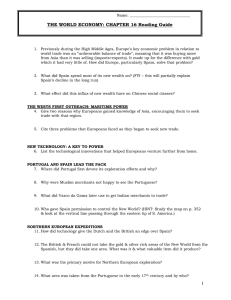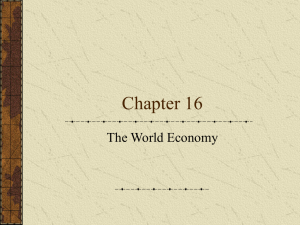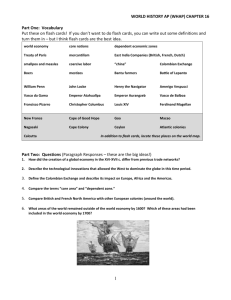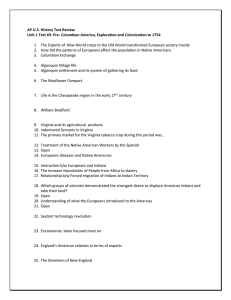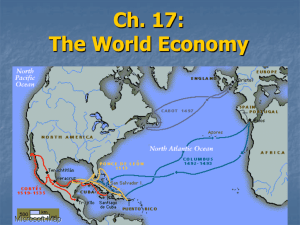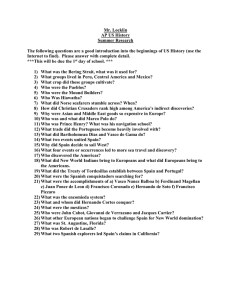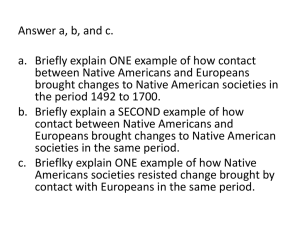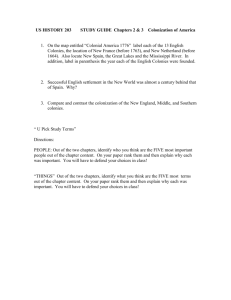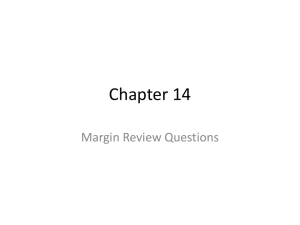Chapter 16 Reading Guide: The World Economy
advertisement
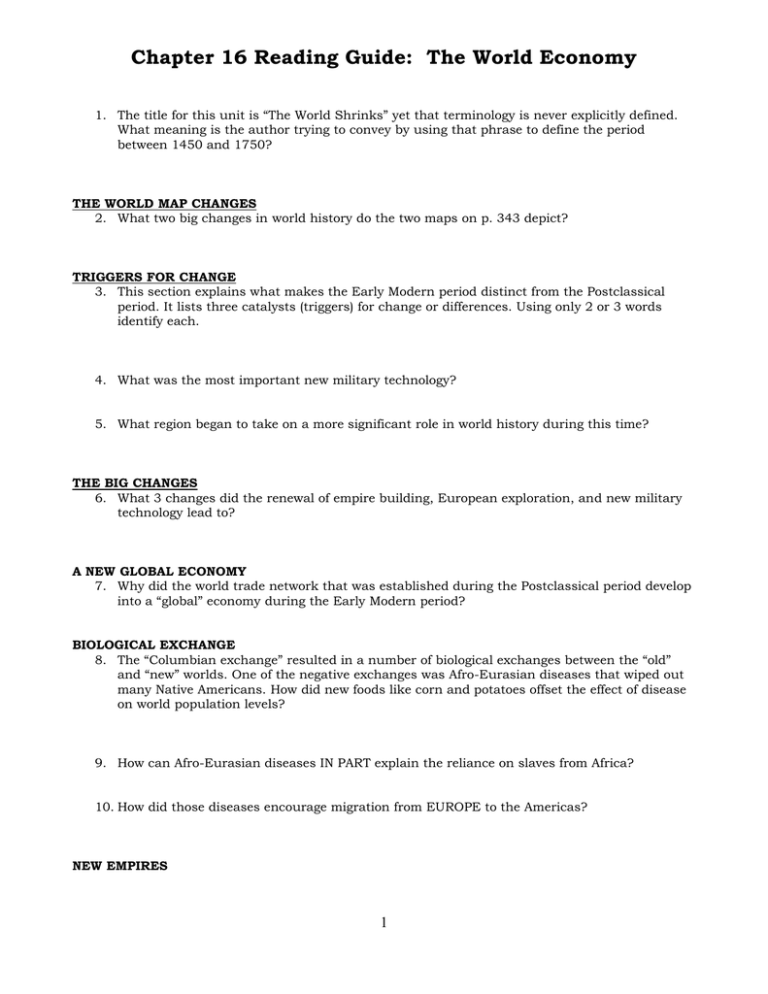
Chapter 16 Reading Guide: The World Economy 1. The title for this unit is “The World Shrinks” yet that terminology is never explicitly defined. What meaning is the author trying to convey by using that phrase to define the period between 1450 and 1750? THE WORLD MAP CHANGES 2. What two big changes in world history do the two maps on p. 343 depict? TRIGGERS FOR CHANGE 3. This section explains what makes the Early Modern period distinct from the Postclassical period. It lists three catalysts (triggers) for change or differences. Using only 2 or 3 words identify each. 4. What was the most important new military technology? 5. What region began to take on a more significant role in world history during this time? THE BIG CHANGES 6. What 3 changes did the renewal of empire building, European exploration, and new military technology lead to? A NEW GLOBAL ECONOMY 7. Why did the world trade network that was established during the Postclassical period develop into a “global” economy during the Early Modern period? BIOLOGICAL EXCHANGE 8. The “Columbian exchange” resulted in a number of biological exchanges between the “old” and “new” worlds. One of the negative exchanges was Afro-Eurasian diseases that wiped out many Native Americans. How did new foods like corn and potatoes offset the effect of disease on world population levels? 9. How can Afro-Eurasian diseases IN PART explain the reliance on slaves from Africa? 10. How did those diseases encourage migration from EUROPE to the Americas? NEW EMPIRES 1 Chapter 16 Reading Guide: The World Economy 11. New empires in India, the Middle East, southeastern Europe, and Russia focused their attention on lands both within their borders and adjacent to them. How did Western European empires differ in where they devoted their energies? CONTINUITY 12. What did NOT change during the Early Modern period. (Read but do not cite the continuities in the 1st and last paragraphs of this section. You should have 3 key continuities.) IMPACT ON DAILY LIFE: WORK 13. What metal became the currency of choice during the Early Modern period? Where do you think it came from? (HINT: NOT Europe – but Europeans had it) 14. How did the use of this new currency affect Chinese peasants? 15. Why was there more pressure to work harder during the Early Modern period? 16. Religion is often co-opted by needs of society to place demands on the people in the name of God (gods). For example, the lack of protein due to the unavailability of domesticable animals in Mesoamerica may have led the Aztecs to practice human sacrifice and cannibalism under the pretense of appeasing their gods. Pork is shunned by people of certain religions but in the past pigs carried many more diseases than today and were detrimental to the ecosystem of the Middle East. European knights were told they would go to Heaven if they went on Crusade. How was religion used to get people in Western Europe to work more during the EM period? 17. How did the pressure to work harder affect children? 18. What key economic distinction is there between the Early Modern period and the present? TRENDS AND SOCIETIES IN THE EARLY MODERN PERIOD 19. Chapters 16 through 22 (the EM chapters) focus on reactions to three commonalities. What are they? (TIP: You really should read an entire subsection before trying to answer a single question. Read 1st, then answer.) 2 Chapter 16 Reading Guide: The World Economy CHAPTER 16: THE WORLD ECONOMY Chapter Summary. The rise of the West between the 15th and 18th centuries involved distant explorations and conquests resulting in a heightening and redefining of relationships among world societies. During the classical era, larger regional economies and culture zones had developed, as in the Chinese Middle Kingdom and the Mediterranean basin, but international exchanges were not of fundamental importance to the societies involved. During the postclassical period, contacts increased and were more significant. Missionary religions—Buddhism and Islam—and trade influenced important changes. The new world relationships after 1450 spelled a new period of world history. The Americas and other world areas were joined to the world network, while older regions had increased contacts. Trade became so significant that new relationships emerged among societies and prompted reconsideration of existing political and cultural traditions. 20. Back in Chapter 15 on pp. 329-330 Europe’s key economic problem in relation to the world trade network is defined as an “unfavorable balance of trade”, meaning that it was buying more from Asia than it was selling (imports>exports). It was having to make up for the difference with gold which it had very little of. How did Europe, particularly Spain, solve that problem? 21. What did Spain spend most of its new wealth on? (FYI – this will partially explain Spain’s decline in the long run compared to England and France because these two things don’t produce anything) 22. What effect did this influx of new wealth have on Chinese social classes? THE WESTS FIRST OUTREACH: MARITIME POWER 23. Give two reasons why Europeans gained knowledge of Asia, encouraging them to seek trade with that region. 24. Cite three problems that Europeans faced as they began to seek new trade. NEW TECHNOLOGY: A KEY TO POWER 25. List the technological innovations that helped Europeans venture further from home. PORTUGAL AND SPAIN LEAD THE PACK 26. Where did Portugal first devote its exploration efforts and why? 3 Chapter 16 Reading Guide: The World Economy 27. What lucky stroke did Vasco da Gama enjoy that helped get his fleet to India? 28. Why were Muslim merchants not happy to see the Portuguese? 29. What did da Gama later use to get Indian merchants to trade? 30. In what year and by whose efforts did Spain claim the Americas? 31. Who gave Spain permission to control the New World? (HINT: Study the map on p. 352 and look at the vertical line passing through the eastern tip of South America and going north through Greenland. ) 32. What did Magellan do for Spain and in what year? NORTHERN EUROPEAN EXPEDITIONS 33. How did technology give the Dutch and the British an edge over Spain? 34. The British and French could not take the gold and silver rich areas of Mexico and South America from the Spanish but they did take one area from Spain. What was it and what very valuable item did it produce? 35. What was the primary motive for Northern European exploration? 36. Although the English did explore part of North America in 1497, they didn’t do much else until when and in what area of North America? (HINT: You studied 13 of these in 8th grade). 37. What area was taken from the Portuguese in the early 17th century and by who? 38. Why was a Dutch colony in South Africa created? 39. Describe the power held by North European trading companies. 4 Chapter 16 Reading Guide: The World Economy 40. Where was the British East India Company most active? IN DEPTH: CAUSATION AND THE WEST’S EXPANSION 41. List the different types of historical causation your text discusses and identify TWO that you most agree with. TOWARD A WORLD ECONOMY 42. List the three changes that resulted from Europe’s dominance of the seas. THE COLUMBIAN EXCHANGE OF DISEASE AND FOOD 43. What was the major negative impact of the Columbian Exchange? 44. How did sweet potatoes end up in China? 45. What was a negative side effect of sweet potatoes, potatoes, and corn on China and Europe? 46. Why would some Europeans not eat American foods? THE WEST’S COMMERCIAL OUTREACH 47. Control of international trade routes resulted in what positive benefit for Europe? 48. What physical features did Europeans seek to control despite not attempting to conquer vast stretches of land inland? 49. Why did European countries want these physical features? 50. Why did even the most isolationist countries such as Japan or some of the most powerful Muslim countries like the Ottoman Empire grant Europeans access to their trade networks? IMBALANCES IN WORLD TRADE 51. Why did Spain lose its lead in world trade to other European countries? 5 Chapter 16 Reading Guide: The World Economy 52. What European countries surpassed Spain? 53. “A business should attempt to sell more than it buys in order to be successful.” This obvious statement in part describes what Early Modern economic policy (that you should have learned in 8th grade!). 54. What were colonies discouraged from doing and why? 55. How did areas dependant to core nations participate in world trade? A SYSTEM OF INTERNATIONAL INEQUALITY 56. Although most people in dependent (to Europe) areas were in poverty, some did benefit from the core-dependent relationship. Identify two industries or groups that benefited from this system and the region they were located in. 57. What “peculiar institution” (Google it!) grew up in most dependent economies and why? 58. Who are “mestizos”? VISUALIZING THE PAST: WEST INDIAN SLAVEHOLDING 59. Analyzing the trends shown on the table. What do they tell us about world demand for sugar? Explain. HOW MUCH WORLD IN THE WORLD ECONOMY? 60. What was the penalty countries incurred for not being part of the world trade system? 61. Explain the statement from the Jesuit missionary: “the military . . . is considered mean among them.” (Go to your computer, Google the definition of mean. It’s used as an adjective and has nothing to do with “cruel” or “harsh”. HINT: Scrooge) 62. Examine the quote from the Western missionary on p. 358 (1st full paragraph, at the end). What is ironic about his statement given what you know about China and innovation during the Postclassical period, particularly the Tang and Song eras? (HINT: p. 274) 63. What is another name for porcelain and why is it known by that name? 6 Chapter 16 Reading Guide: The World Economy 64. When China refused to meet European demand for porcelain, what did Europeans do to make up for it? 65. What European technologies were the Japanese interested in? THE EXPANSIONIST TREND 66. Why did Britain ban the importation of cotton cloth from India? 67. What happened in India as a result of greater involvement in the world trade system? 68. What role did Eastern Europe play in the world trade system? 69. Who suffered in Eastern Europe as a result of this role? COLONIAL EXPANSION THE AMERICAS: LOOSELY CONTROLLED COLONIES 70. Who founded the first colony on the mainland of the Americas, where was it, and under what country’s flag? 71. What empire did Francisco Pizarro conquer? 72. Your text calls him “treacherous”. What did he do that earned him that dishonorable description? 73. One of the early goals of various colonial powers was to find gold. What was a religious goal? 74. Where did France focus its colonization efforts? 75. What about Britain and Holland? 7 Chapter 16 Reading Guide: The World Economy DOCUMENT: WESTERN CONQUERORS: TACTICS AND MOTIVES 76. Although the letter by Columbus is by his own hand, why should a reader be skeptical of some of his claims? (HINT: Read the 2nd to last paragraph carefully to find the catch.) 77. What is similar in the descriptions of Native Americans in both accounts? BRITISH AND FRENCH NORTH AMERICA: BACKWATER COLONIES 78. New York was originally founded by who? (HINT: at the time it was called New Amsterdam) 79. Describe the conflict known as the Seven Years War by identifying the main opponents, the treaty that ended it, and what the winner gained. (FYI – this was called the French and Indian War here in America) 80. How did the value of North American colonies compare to colonies in the Caribbean or Latin America? 81. Why were the British colonies more similar to societies in Western Europe than the colonies in Latin America? (HINT: I’ve told you before to read the entire subsection before answering a question. Stronger clue near the end.) 82. What did Great Britain do after the Seven Years War that angered the colonies in North America? (You learned this in 8th grade too.) 83. What class developed in North America that did not develop elsewhere in the Americas? 84. How did the Indian population of North America compare to Central America? 85. North Americans saw themselves as part of a larger Western civilization yet they did something that was distinctive from European countries. What was it? NORTH AMERICA AND WESTERN CIVILIATION 86. Compare and contrast the family patterns in North America to Western Europe. 8 Chapter 16 Reading Guide: The World Economy AFRICA AND ASIA: COASTAL TRADING STATIONS 87. Why didn’t Europeans push into the interior of Africa? 88. What power placed a colony on the southern tip of Africa? 89. What were their farmers called and who did those farmers come into conflict with up until the end of the 20th century? 90. What powers fought over India? 91. Why might Indians have preferred one of those powers over the other? 92. What was the “black hole of Calcutta?” 93. What area was successfully converted to Christianity by missionaries? IMPACT ON WESTERN EUROPE 94. Why should World War 1 possibly be renamed World War 2 and World War 2 renamed World War 3? 95. What effect did colonies have on the availability of sugar, and thus candy and sweets, and tooth decay? 96. VERY VERY IMPORTANT! The wealth brought in from colonies enabled Europeans, especially the British, to switch to a new economic basis. The first such switch since the change from hunting and gathering to agriculture. What was this new basis? THE IMPACT OF A NEW WORLD ORDER 97. What similar role did Eastern Europe and Latin America play in the world economy? 98. How did this new world economy help some societies? GLOBAL CONNECTIONS: THE WORLD ECONOMY – AND THE WORLD 99. What aspects of Western power increased as a result of this new role in world trade? 9
